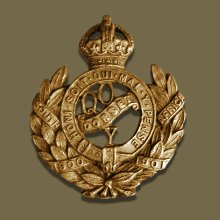
Queen's Own Dorset Yeomanry
The Queen's Own Dorset Yeomanry was a yeomanry regiment of the British Army founded in 1794 as the Dorsetshire Regiment of Volunteer Yeomanry Cavalry in response to the growing threat of invasion during the Napoleonic wars. It gained its first royal association in 1833 as The Princess Victoria's Regiment of Dorset Yeomanry Cavalry, and its second, in 1843, as the Queen's Own Regiment of Dorset Yeomanry Cavalry.
Queen's Own Dorset Yeomanry
1794 – 1802
1803 – 1814
1830 – 1967
1997 – present
![]() Kingdom of Great Britain (1794–1800)
Kingdom of Great Britain (1794–1800)![]() United Kingdom (1801–present)
United Kingdom (1801–present)
Yeomanry (Second Boer War)
Yeomanry (First World War)
Artillery (Second World War)
Lieutenant General Arundell D. Leakey, CMG, CVO, CBE[1]
History[edit]
Formation and early history[edit]
Under threat of invasion by the French Revolutionary government from 1793, and with insufficient military forces to repulse such an attack, the British government under William Pitt the Younger decided in 1794 to increase the Militia and to form corps of volunteers for the defence of the country. The mounted arm of the volunteers became known as the "Gentlemen and Yeomanry Cavalry".[2]
The Dorset Yeomanry was first raised on 9 May 1794 as the Dorsetshire Regiment of Volunteer Yeomanry Cavalry of six troops. In 1796, it became the Dorsetshire Rangers and now consisted of ten troops. In 1802, it was disbanded[3] as a result of the Treaty of Amiens and the consequent peace.[4]
With the ending of the Peace of Amiens in 1803,[4] the regiment was re-raised as the Dorsetshire Regiment of Volunteer Yeomanry Cavalry, consisting of seven troops. In 1814, it was once again disbanded.[3]
The next, and longest lived, incarnation came in 1830 when the Dorsetshire Regiment of Volunteer Yeomanry Cavalry was reformed from troops at Wimborne, Blandford, Isle of Purbeck, Wareham and Charborough. In 1833 it gained royal patronage as The Princess Victoria's Regiment of Dorset Yeomanry Cavalry and in June 1843 became the Queen's Own Regiment of Dorset Yeomanry Cavalry. At some point thereafter it was renamed as the Dorset Yeomanry (Queen's Own) with headquarters at Dorchester.[3]
Uniforms[edit]
During the period 1830 to 1847, the regiment wore a shako with scarlet coatee and blue facings. After 1850, a dark blue tunic was introduced and in 1883 a hussar style uniform, complete with white looped braiding and busby, was adopted. Following the Boer War a khaki uniform with green facings replaced the blue uniforms, to be worn with a slouch hat. This practical dress proved unpopular for recruiting purposes and, by 1908, officers had for full dress reverted to the 19th century dark blue hussar uniform, with silver braiding, scarlet facings and plumed busby. Other ranks had plainer "blues" for parade and walking out dress.[39] Subsequently, khaki service and battle dress of standard British Army pattern was worn for nearly all occasions.[40]